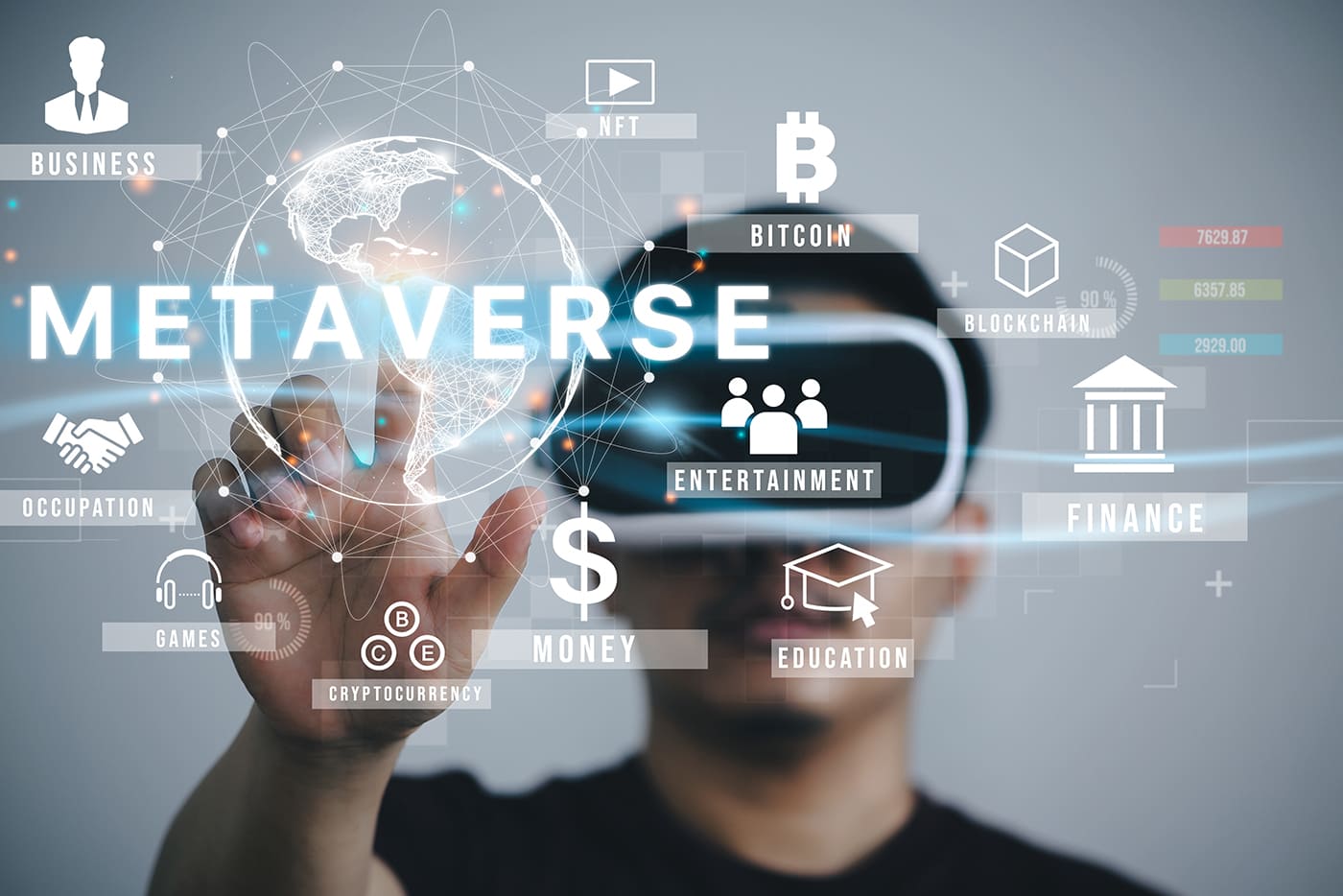Introduction
The concept of the metaverse has gained significant attention in recent years, fueled by advancements in technology and a growing desire for immersive and connected virtual experiences. The metaverse is a virtual universe where individuals can interact with each other and digital environments in real-time, blurring the boundaries between the physical and digital worlds.
Imagine a world where you can explore stunning virtual landscapes, socialize with friends from different parts of the globe, attend virtual events, and engage in a wide range of activities, all within a digital realm that feels incredibly real. That is the essence of the metaverse.
Although the term “metaverse” was popularized through science fiction and movies, the idea of a fully realized metaverse is becoming more attainable due to advances in technologies such as virtual reality (VR), augmented reality (AR), artificial intelligence (AI), and blockchain. These technologies are the building blocks that will enable the creation of a seamless and interconnected metaverse.
In this article, we will explore the key components and steps involved in creating a metaverse. From building the underlying infrastructure to fostering an inclusive and diverse community, each step plays a crucial role in the development and success of the metaverse.
So, let’s dive into the fascinating world of the metaverse and discover how this technological marvel can reshape the way we live, work, and interact in the digital age.
Defining the Metaverse
The term “metaverse” is often used to describe a virtual reality environment where individuals can interact with each other and digital objects in a shared space. It is a collective virtual realm that encompasses various interconnected digital worlds, allowing seamless movement and interaction across different virtual environments.
The metaverse goes beyond traditional online platforms and social media networks. It aims to provide a more immersive and interactive experience by incorporating elements of virtual reality, augmented reality, and other emerging technologies.
In the metaverse, users can navigate through virtual landscapes, create and customize avatars, engage in virtual commerce, attend virtual events and conferences, and even pursue educational and professional opportunities. It is a dynamic and ever-evolving digital universe where the boundaries between the physical and digital realms are blurred.
One of the key aspects of the metaverse is its interoperability. This means that various virtual worlds within the metaverse can seamlessly connect with each other, allowing users to move their avatars, assets, and data across different platforms and experiences. It fosters a sense of continuity and interconnectedness, enhancing the overall user experience.
Another important characteristic of the metaverse is the concept of persistence. Unlike traditional video games or virtual environments that reset with each session, the metaverse is persistent, meaning that changes made by users are permanent and can be experienced by others in real-time. This creates a sense of shared history and a deeper level of engagement.
It is worth noting that the metaverse is not limited to a single platform or company. It is a decentralized network of virtual worlds and experiences that is driven by collaboration and open standards. This ensures that the metaverse remains accessible and inclusive, allowing individuals from different backgrounds and interests to participate and contribute to its development.
Overall, the metaverse represents a new frontier in digital interaction and entertainment. It has the potential to revolutionize the way we connect, create, and experience the digital world, opening a wide range of opportunities for individuals, businesses, and communities.
Understanding the Technology Behind the Metaverse
The metaverse is powered by a combination of advanced technologies that work together to create a seamless and immersive virtual experience. Let’s take a closer look at some of the key technologies behind the metaverse:
-
Virtual Reality (VR) and Augmented Reality (AR):
VR and AR technologies are fundamental components of the metaverse. VR immerses users in a completely virtual environment, whereas AR overlays digital information onto the real world. These technologies provide the sensory inputs necessary to create an immersive experience within the metaverse. -
Artificial Intelligence (AI):
AI plays a crucial role in the metaverse by driving realistic simulations, intelligent agents, and dynamic content generation. AI algorithms enable virtual characters and objects within the metaverse to behave and interact intelligently, enhancing the overall realism and user engagement. -
Blockchain Technology:
Blockchain technology ensures trust, transparency, and security within the metaverse. It enables secure ownership and transfer of digital assets, such as virtual land, virtual goods, and digital currencies. Blockchain also facilitates decentralized governance and enables the creation of vibrant virtual economies within the metaverse. -
Cloud Computing:
The metaverse relies on robust cloud computing infrastructure to handle the massive amounts of data and processing power required for real-time interactions and rendering. Cloud computing provides the scalability and flexibility needed to support a large number of users and complex virtual environments. -
Internet of Things (IoT):
IoT devices, such as virtual reality headsets, motion trackers, and haptic feedback systems, enhance the user experience within the metaverse. These devices collect and transmit real-world data, enabling users to interact with the virtual environment in more natural and intuitive ways.
These technologies work in synergy to create a rich and immersive metaverse experience. By leveraging VR, AR, AI, blockchain, cloud computing, and IoT, the metaverse breaks the barriers of traditional virtual worlds and creates a dynamic and interconnected digital universe where users can explore, interact, and create in unprecedented ways.
Step 1: Building the Infrastructure
Building the infrastructure is the first crucial step in creating a metaverse. It involves establishing the underlying technology and architecture that will support the virtual world and enable seamless connectivity and interactions. Here are some key considerations when it comes to building the infrastructure for the metaverse:
-
Scalable Servers and Network:
The metaverse requires a robust and scalable server infrastructure to handle the ever-increasing number of users and their interactions. High-performance servers and a reliable network infrastructure are essential to ensure smooth real-time interactions and minimize latency. -
Cloud Computing:
Cloud computing plays a vital role in the metaverse by providing the necessary computing resources and storage capacity. Leveraging cloud infrastructure allows for scalability, flexibility, and cost-effectiveness, as virtual worlds can dynamically allocate resources based on demand. -
Interoperability Protocols:
Interoperability is crucial in the metaverse, as it allows different platforms and virtual worlds to seamlessly connect and communicate with each other. Developing and implementing interoperability protocols ensures that avatars, assets, and experiences can be transferred and accessed across various metaverse platforms. -
Data Management and Storage:
Managing and storing vast amounts of user-generated data is a significant challenge in the metaverse. Implementing efficient data management and storage solutions ensure that user data is secure, accessible, and can be efficiently retrieved and synchronized across different virtual environments. -
Security and Privacy:
Ensuring the security and privacy of users’ personal information and digital assets is crucial in the metaverse. Implementing robust security measures, such as encryption, access controls, and identity verification protocols, helps protect users from unauthorized access and ensures a safe and trusted environment.
By focusing on building a reliable, scalable, and interoperable infrastructure, the metaverse can provide a seamless and immersive experience for users. It lays the foundation for the development of virtual worlds, interactions, and experiences that will shape the future of the metaverse.
Step 2: Developing the Virtual World
Developing the virtual world is a critical step in creating the metaverse. It involves designing and constructing the immersive environments, objects, and experiences that users will interact with. Here are some key considerations when it comes to developing the virtual world:
-
Designing the Virtual Environments:
Creating captivating and realistic virtual environments is essential in the metaverse. Designers use various tools and techniques to build visually stunning landscapes, buildings, and objects that replicate real-world or imagined settings. Attention to detail, visual aesthetics, and interactive elements contribute to the overall user experience. -
Avatar Creation and Customization:
Avatars serve as the virtual representation of users within the metaverse. Providing users with the ability to create and customize their avatars enhances personalization and self-expression. Incorporating a wide range of options for appearance, clothing, accessories, and behaviors allows users to craft unique virtual identities. -
Object and Asset Creation:
Developing a diverse range of virtual objects and assets enriches the metaverse experience. Whether it’s virtual furniture, vehicles, or even virtual pets, offering a wide selection of objects allows users to decorate their virtual spaces and engage in virtual commerce. Collaboration with creators and developers can help generate a vibrant ecosystem of virtual goods and services. -
Physics and Interactions:
Realistic physics and interactions add depth and immersion to the virtual world. Implementing physics-based simulations for movement, collision detection, and object behavior creates a more lifelike experience. Enabling user interactions, such as picking up objects, opening doors, or manipulating the environment, fosters engagement and interactivity. -
Audio and Ambiance:
Sound plays a crucial role in creating an immersive virtual world. Incorporating high-quality audio effects, spatial sound, and ambient background noises enhances the realism and immersion. From environmental sounds to character voices, audio elements contribute to the overall atmosphere and user experience.
By focusing on developing a visually stunning, interactive, and immersive virtual world, the metaverse can provide users with a captivating and engaging experience. It allows individuals to explore, create, and connect within digital environments that feel remarkably real.
Step 3: Implementing Interoperability and Connectivity
Interoperability and connectivity are crucial components of the metaverse, enabling seamless interactions and experiences across different platforms and virtual worlds. Implementing interoperability and connectivity involves ensuring that avatars, assets, and data can be shared and accessed across various metaverse environments. Here are key considerations for implementing interoperability and connectivity:
-
Open Standards and Protocols:
Establishing open standards and protocols is essential for interoperability. By adopting common standards, different metaverse platforms can communicate and exchange information effectively. This allows users to move their avatars, assets, and data seamlessly between different virtual worlds. -
Avatar and Asset Portability:
Providing users with the ability to transfer their avatars and assets across different metaverse environments enhances their flexibility and freedom. Implementing standardized avatar and asset formats ensures that users can preserve and use their virtual identities and belongings in multiple virtual worlds. -
Cross-Platform Communication:
Enabling cross-platform communication is crucial for fostering seamless interactions between users on different metaverse platforms. Implementing protocols for real-time voice, chat, and video communication helps break down barriers, allowing individuals to socialize and collaborate in a connected metaverse. -
Virtual World Portals:
Virtual world portals serve as gateways that connect different virtual environments within the metaverse. Implementing portal technologies allows users to seamlessly move between virtual worlds, preserving their avatars, assets, and social connections. This promotes exploration and connectivity within the metaverse. -
Metaverse Marketplaces:
Metaverse marketplaces act as hubs for buying, selling, and trading virtual goods and services. Implementing interoperability allows users to trade assets and currencies across different marketplaces, fostering a vibrant and interconnected virtual economy.
By implementing interoperability and connectivity, the metaverse becomes a unified and interconnected digital universe. Users can seamlessly navigate and interact across different metaverse environments, ensuring a coherent and engaging experience. The ability to transfer avatars, assets, and data promotes user freedom and encourages collaboration and exploration within the metaverse.
Step 4: Integrating Augmented Reality (AR) and Virtual Reality (VR)
Integrating augmented reality (AR) and virtual reality (VR) technologies is a significant step in the development of the metaverse. AR and VR enhance the immersive and interactive nature of the metaverse, creating a more engaging and realistic user experience. Here are key considerations for integrating AR and VR:
-
Virtual Reality (VR):
VR technology transports users into fully immersive virtual environments, blocking out the physical world and replacing it with a digital one. By integrating VR into the metaverse, users can explore and interact with digital landscapes and objects as if they were physically present. VR headsets with advanced tracking and motion capabilities enhance the realism and immersion of the virtual experience. -
Augmented Reality (AR):
AR overlays digital information onto the real world, enhancing the physical environment with digital elements. By integrating AR into the metaverse, users can interact with virtual objects and information within their actual surroundings. Smart glasses, smartphones, and other AR devices enable users to seamlessly blend the digital and physical worlds, opening up new possibilities for exploration and interaction. -
Mixed Reality (MR):
Mixed reality combines both VR and AR, allowing users to interact with both virtual and real-world elements simultaneously. By integrating MR into the metaverse, users can engage with realistic virtual objects within their physical environment. This technology enables compelling and immersive experiences that seamlessly merge the virtual and physical realms. -
Gesture and Motion Tracking:
Gesture and motion tracking technologies allow users to interact with the metaverse using natural movements and gestures. By incorporating advanced tracking systems, users can manipulate virtual objects, navigate virtual environments, and even communicate through hand gestures, enhancing the sense of presence and immersion within the metaverse. -
Spatial Audio:
Spatial audio technology enhances the immersive experience by simulating three-dimensional sound within the metaverse. By integrating spatial audio, virtual environments become more realistic and dynamic, providing users with a sense of presence and enhancing situational awareness.
By integrating AR and VR technologies into the metaverse, users can immerse themselves in fully interactive and realistic virtual experiences. The combination of these technologies enhances the engagement, interactivity, and immersion within the metaverse, pushing the boundaries of digital exploration and interaction.
Step 5: Ensuring Security and Privacy
Ensuring security and privacy is a critical step in the development of the metaverse. With the vast amount of personal and financial information being exchanged within virtual environments, it’s essential to establish robust security measures to protect users’ data and privacy. Here are key considerations for ensuring security and privacy in the metaverse:
-
Encryption and Secure Communication:
Implementing encryption protocols ensures that data transmitted within the metaverse remains secure and protected from unauthorized access. Secure communication channels prevent eavesdropping and safeguard sensitive user information. -
User Authentication and Identity Verification:
Implementing strong user authentication and identity verification processes helps ensure that only authorized individuals can access and participate in the metaverse. Multifactor authentication methods, biometric verification, and digital identity systems enhance security and minimize the risk of identity theft. -
Virtual Asset Protection:
Protecting virtual assets, such as virtual currency, virtual property, and digital collectibles, is crucial in the metaverse. Applying secure ownership frameworks, blockchain technology, and decentralized storage systems help prevent unauthorized copying, alteration, or theft of virtual assets. -
Secure Virtual Transactions:
Facilitating secure and trusted virtual transactions is paramount in the metaverse. Implementing secure payment gateways, encrypted digital wallets, and smart contract technology helps protect users’ financial information and ensures the integrity of virtual transactions. -
User Data Protection:
Safeguarding users’ personal data and respecting privacy rights is essential in the metaverse. Implementing transparent data collection practices, obtaining user consent, and adhering to data protection regulations help build trust and protect user privacy within the metaverse.
By prioritizing security and privacy measures, the metaverse can create a safe and trustworthy environment for users. Establishing strong security protocols, protecting virtual assets, and respecting user privacy rights are crucial in building user confidence and fostering a positive user experience within the metaverse.
Step 6: Fostering User Engagement and Interaction
Fostering user engagement and interaction is a key step in the development of the metaverse. The success of the metaverse relies on creating a vibrant and active community of users who are immersed in a wide range of engaging experiences. Here are key considerations for fostering user engagement and interaction in the metaverse:
-
Social Interactions:
Facilitating social interactions is essential in the metaverse. Implementing features such as real-time chat, voice communication, and virtual gatherings enable users to connect, communicate, and collaborate with each other, fostering a sense of community and camaraderie. -
User-generated Content:
Empowering users to create and share their own content within the metaverse encourages creativity and engagement. Providing tools and platforms for user-generated content, such as virtual world editors or programming interfaces, enables users to express themselves and contribute to the metaverse community. -
Virtual Events and Activities:
Organizing virtual events, conferences, and activities within the metaverse creates opportunities for users to gather, network, and learn. Promoting and supporting virtual trade shows, concerts, art exhibitions, and educational workshops enhances user engagement and provides diverse experiences. -
Collaboration and Co-creation:
Enabling users to collaborate and co-create within the metaverse fosters a sense of ownership and involvement. Implementing shared virtual workspaces, collaborative building tools, and creative platforms allows users to work together, exchange ideas, and contribute to the evolution of the metaverse. -
Recognition and Rewards:
Implementing systems that recognize and reward user achievements and contributions within the metaverse boosts user motivation and engagement. Integration of achievement badges, leaderboards, virtual currencies, and other forms of virtual rewards encourages users to actively participate and excel within the metaverse.
By focusing on fostering user engagement and interaction, the metaverse becomes a thriving ecosystem where users feel connected, motivated, and actively involved. Enabling social interactions, supporting user-generated content, organizing virtual events, promoting collaboration, and providing recognition and rewards contribute to the vibrancy and growth of the metaverse community.
Step 7: Creating a Sustainable Economic System
Creating a sustainable economic system is a crucial step in the development of the metaverse. A robust and balanced economic framework ensures that the metaverse can support a thriving ecosystem of virtual commerce, incentivize user participation, and drive ongoing growth. Here are key considerations for creating a sustainable economic system in the metaverse:
-
Virtual Currencies:
Implementing a virtual currency system within the metaverse provides a medium of exchange for goods and services. Virtual currencies enable seamless and secure transactions, empower users to participate in the virtual economy, and stimulate economic activities within the metaverse. -
Virtual Commerce:
Fostering virtual commerce is essential for a sustainable metaverse economy. Creating virtual marketplaces, auction houses, and storefronts allows users to buy and sell virtual assets, virtual goods, and services. Encouraging virtual entrepreneurship and enabling user-to-user transactions fosters economic growth and community engagement. -
Virtual Property Rights:
Defining and enforcing virtual property rights is crucial for a sustainable metaverse economy. Users should have clear ownership rights over virtual land, virtual objects, and digital creations. Establishing frameworks for virtual property rights ensures fairness, encourages investment, and rewards user creativity and contributions. -
Economic Balancing:
Maintaining a balanced economic system within the metaverse is essential to prevent inflation, market monopolies, and unfair wealth distribution. Implementing mechanisms such as virtual taxes, supply and demand dynamics, and regulating rare or limited edition virtual assets help create a healthy and sustainable economic ecosystem. -
Rewarding User Contributions:
Recognizing and rewarding user contributions to the metaverse economy incentivizes active participation. Providing opportunities for users to earn virtual currencies, virtual goods, or special privileges for their contributions encourages creativity, engagement, and ongoing participation in the metaverse.
By focusing on creating a sustainable economic system, the metaverse becomes a dynamic and self-sustaining digital economy. Implementing virtual currencies, supporting virtual commerce, establishing property rights, maintaining economic balance, and rewarding user contributions ensure that the metaverse economy remains vibrant and beneficial for all participants.
Step 8: Nurturing an Inclusive and Diverse Community
Nurturing an inclusive and diverse community is a crucial step in the development of the metaverse. It is essential to create an environment where individuals from all backgrounds feel welcome, respected, and represented. By fostering inclusivity and diversity, the metaverse can become a vibrant and dynamic digital space. Here are key considerations for nurturing an inclusive and diverse community within the metaverse:
-
Accessibility:
Ensuring that the metaverse is accessible to individuals with disabilities is vital in creating an inclusive community. Incorporating accessibility features, such as text-to-speech functionality, captioning, and customizable interfaces, enables individuals with different abilities to engage and participate in the metaverse. -
Cultural Sensitivity:
Embracing cultural diversity and promoting respect for different cultures is essential in the metaverse. Fostering an environment that celebrates cultural expression, customs, and traditions helps create a welcoming and inclusive community where individuals can learn from and appreciate each other’s backgrounds. -
Safe Spaces and Moderation:
Implementing robust moderation and community guidelines ensures that the metaverse remains a safe and respectful environment for all users. Handling instances of harassment, hate speech, and offensive behavior helps maintain a positive and inclusive atmosphere within the metaverse. -
Representation and Inclusivity:
Striving for diverse representation in the metaverse is crucial. By promoting diverse avatars, characters, and content, users can see themselves and their identities reflected within the digital space. Encouraging inclusivity and representation fosters a sense of belonging and cultivates a rich and diverse metaverse community. -
Support and Education:
Providing support and educational resources to users helps foster an inclusive and supportive community. Offering tutorials, mentorship programs, and community forums promotes knowledge sharing, collaboration, and empowers users of all skill levels to engage and contribute to the metaverse.
Nurturing an inclusive and diverse community within the metaverse creates an environment that celebrates differences, encourages mutual respect, and facilitates meaningful connections. By fostering accessibility, cultural sensitivity, safe spaces, representation, and support, the metaverse can become a truly inclusive digital space where everyone feels valued and can thrive.
Conclusion
The concept of the metaverse offers an exciting vision of a fully immersive and connected virtual universe where individuals can explore, interact, and create in unprecedented ways. Through the integration of advanced technologies such as VR, AR, AI, and blockchain, the metaverse has the potential to reshape how we live, work, and interact in the digital age.
Creating the metaverse involves a series of key steps, each playing a crucial role in its development and success. Building the infrastructure, developing the virtual world, implementing interoperability and connectivity, integrating AR and VR, ensuring security and privacy, fostering user engagement and interaction, creating a sustainable economic system, and nurturing an inclusive and diverse community are all essential components of the metaverse’s evolution.
As the metaverse continues to evolve, it is important to strike a balance between technological advancements and human-centered experiences. By infusing creativity, inclusivity, and diversity into the development of the metaverse, we can ensure that it becomes a truly immersive, engaging, and enriching digital space for people from all walks of life.
The metaverse holds immense potential to transform industries, revolutionize entertainment, and redefine social interactions. It opens up a world of possibilities for individuals, businesses, and communities to connect, create, and thrive in a virtual environment that feels remarkably real.
However, it is essential to approach the development of the metaverse with ethical considerations, taking into account user privacy, data protection, and equitable opportunities for participation. By addressing these challenges, we can create a metaverse that is inclusive, secure, and respectful of individuals’ rights and diversity.
As the metaverse continues to evolve and mature, it will require ongoing collaboration, innovation, and adaptation. By embracing the potential of the metaverse and working together to shape its future, we can unlock a new era of digital experiences that enhance our lives, foster creativity, and connect us in ways we never thought possible.

























